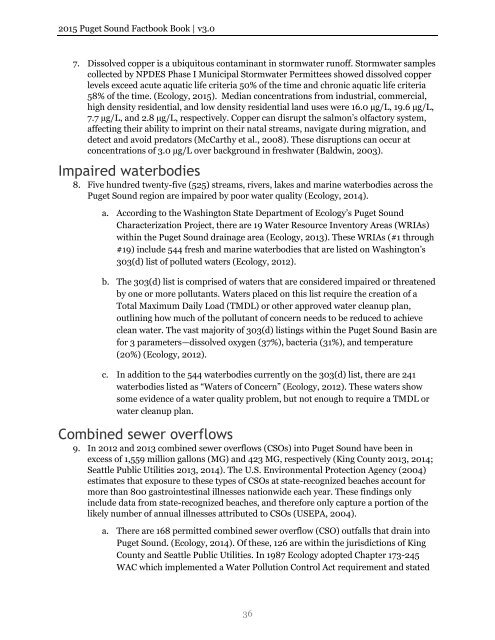Create successful ePaper yourself
Turn your PDF publications into a flip-book with our unique Google optimized e-Paper software.
2015 <strong>Puget</strong> <strong>Sound</strong> Factbook Book | v3.0<br />
7. Dissolved copper is a ubiquitous contaminant in stormwater runoff. Stormwater samples<br />
collected by NPDES Phase I Municipal Stormwater Permittees showed dissolved copper<br />
levels exceed acute aquatic life criteria 50% of <strong>the</strong> time and chronic aquatic life criteria<br />
58% of <strong>the</strong> time. (Ecology, 2015). Median concentrations from industrial, commercial,<br />
high density residential, and low density residential land uses were 16.0 µg/L, 19.6 µg/L,<br />
7.7 µg/L, and 2.8 µg/L, respectively. Copper can disrupt <strong>the</strong> salmon’s olfactory system,<br />
affecting <strong>the</strong>ir ability to imprint on <strong>the</strong>ir natal streams, navigate during migration, and<br />
detect and avoid predators (McCarthy et al., 2008). These disruptions can occur at<br />
concentrations of 3.0 µg/L over background in freshwater (Baldwin, 2003).<br />
Impaired waterbodies<br />
8. Five hundred twenty-five (525) streams, rivers, lakes and marine waterbodies across <strong>the</strong><br />
<strong>Puget</strong> <strong>Sound</strong> region are impaired by poor water quality (Ecology, 2014).<br />
a. According to <strong>the</strong> Washington State Department of Ecology’s <strong>Puget</strong> <strong>Sound</strong><br />
Characterization Project, <strong>the</strong>re are 19 Water Resource Inventory Areas (WRIAs)<br />
within <strong>the</strong> <strong>Puget</strong> <strong>Sound</strong> drainage area (Ecology, 2013). These WRIAs (#1 through<br />
#19) include 544 fresh and marine waterbodies that are listed on Washington’s<br />
303(d) list of polluted waters (Ecology, 2012).<br />
b. The 303(d) list is comprised of waters that are considered impaired or threatened<br />
by one or more pollutants. Waters placed on this list require <strong>the</strong> creation of a<br />
Total Maximum Daily Load (TMDL) or o<strong>the</strong>r approved water cleanup plan,<br />
outlining how much of <strong>the</strong> pollutant of concern needs to be reduced to achieve<br />
clean water. The vast majority of 303(d) listings within <strong>the</strong> <strong>Puget</strong> <strong>Sound</strong> Basin are<br />
for 3 parameters—dissolved oxygen (37%), bacteria (31%), and temperature<br />
(20%) (Ecology, 2012).<br />
c. In addition to <strong>the</strong> 544 waterbodies currently on <strong>the</strong> 303(d) list, <strong>the</strong>re are 241<br />
waterbodies listed as “Waters of Concern” (Ecology, 2012). These waters show<br />
some evidence of a water quality problem, but not enough to require a TMDL or<br />
water cleanup plan.<br />
Combined sewer overflows<br />
9. In 2012 and 2013 combined sewer overflows (CSOs) into <strong>Puget</strong> <strong>Sound</strong> have been in<br />
excess of 1,559 million gallons (MG) and 423 MG, respectively (King County 2013, 2014;<br />
Seattle Public Utilities 2013, 2014). The U.S. Environmental Protection Agency (2004)<br />
estimates that exposure to <strong>the</strong>se types of CSOs at state-recognized beaches account for<br />
more than 800 gastrointestinal illnesses nationwide each year. These findings only<br />
include data from state-recognized beaches, and <strong>the</strong>refore only capture a portion of <strong>the</strong><br />
likely number of annual illnesses attributed to CSOs (USEPA, 2004).<br />
a. There are 168 permitted combined sewer overflow (CSO) outfalls that drain into<br />
<strong>Puget</strong> <strong>Sound</strong>. (Ecology, 2014). Of <strong>the</strong>se, 126 are within <strong>the</strong> jurisdictions of King<br />
County and Seattle Public Utilities. In 1987 Ecology adopted Chapter 173-245<br />
WAC which implemented a Water Pollution Control Act requirement and stated<br />
36


